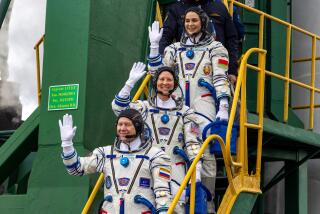Soviets Launch Two Mir Cosmonauts--and an Ad Campaign
- Share via
BAIKONUR COSMODROME, Soviet Union — Two cosmonauts riding an advertising-emblazoned rocket blasted off early today in search of a Soviet space success after a series of failures and bitter disputes over costs.
Mission commander Alexander S. Viktorenko and engineer Alexander A. Serebrov rode into orbit on schedule at 1:38 a.m. today, Moscow time, on their way to a rendezvous with the Mir orbiting space complex. They are expected to dock with Mir on Friday.
Their Soyuz TM-8 capsule dropped two booster rockets, one carrying a 150-foot-high ad for an Italian insurance company, before becoming a pinpoint of light in the sky over Soviet Central Asia.
Official Radio Moscow interrupted regular programming to announce the liftoff. The Tass news agency issued a “flash” report of the launch several minutes later. It said the astronauts were in good condition and the Soyuz capsule was functioning normally.
Viktorenko and Serebrov have a busy schedule of space construction and science laid out for them during their six-month mission aboard the now vacant orbital station. But from the way their mission has been promoted, the public relations aspects are also important.
Soviet officials have stressed that such space flights can yield practical dividends sorely needed in a country now struggling with economic and environmental woes, and they pounded home the theme in the final hours before the cosmonauts’ liftoff.
To help their country’s space program pay more of its own way, the Soviets allowed commercial advertising on the flight.
One of three stages of the 150-foot booster rocket, painted orange, carried an ad for the Italian company Generali. Other ads, for a Soviet electronics company and “New Dawn” perfume, were displayed on a side of the launch pad.
The 20-ton Mir was designed to be permanently manned, and two cosmonauts ended a year on the space station in 1988.
It was unexpectedly mothballed in April, however, because two add-on modules were not ready and the Kremlin did not want to keep a crew aboard while lawmakers and ordinary people were demanding more spending at home.
“If we had colossal sums, we could have had the two modules on time, but we have limited resources like everyone else,” Lt. Gen. Vladimir A. Shatalov, head of cosmonaut training, said.
Deciding to leave the Mir unoccupied for only the second time since it was launched in February, 1986, showed a new sensitivity to public opinion by the Soviet space bureaucracy.
Space officials invited reporters from all 15 Soviet republics and several Western countries to the huge Baikonur Cosmodrome, 1,560 miles southeast of Moscow in Kazakhstan, to watch the blastoff.
They also showed off the new space shuttle Buran and its ground facilities, gave news conferences and allowed reporters to roam freely in the once restricted nearby city of Leninsk.
In a scene unlikely at NASA’s Cape Canaveral, journalists were even allowed on a flatbed railroad car that carried the 310-ton capsule and booster assembly to the launch pad at dawn Monday.
Yuri P. Semenov, the chief engineer, said the Soviet Union spent 1.3 billion rubles ($2 billion) on its civilian space program last year and the TM-8 mission cost 90 million rubles ($138.8 million).
He estimated potential economic benefits from the flight, such as discovery of mineral deposits using Mir’s remote sensing equipment, at 86 million rubles ($132 million).
Officials said the new modules were nearly finished and that the two cosmonauts will attach them in October and February.
The first new module features a shower and sink, air lock for spacewalks and an incubator in which Japanese quail eggs will be hatched to study the effects of weightlessness on heredity. The second has a telescopic camera for studying the stars, a docking port for the Buran shuttle and equipment to grow vegetables.
More to Read
Sign up for Essential California
The most important California stories and recommendations in your inbox every morning.
You may occasionally receive promotional content from the Los Angeles Times.













